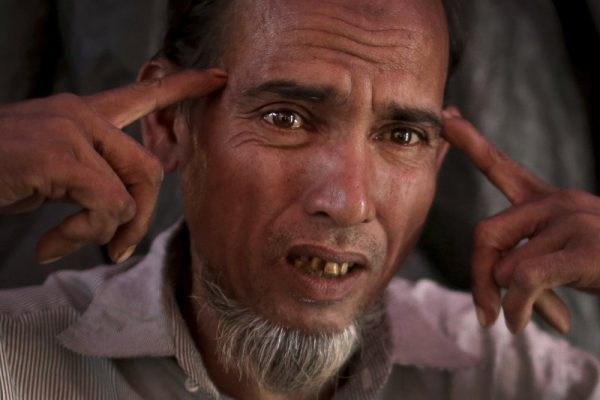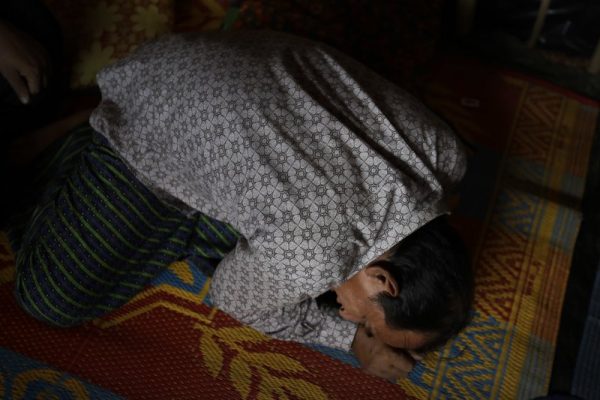
For six hours he hid in an upstairs room, listening to the crackle of gunfire and the screams of people being slaughtered outside his Myanmar home.
With every footstep that drew near, every cry that pierced the air, 52-year-old Bodru Duza braced for the soldiers to find him, to kill him like all the others who had fled to his compound that morning seeking a safe place to shelter. They were being blindfolded and bound, marched away in small groups, then butchered and shot as they begged for their lives.
What had started out as a quiet Sunday in northwestern Myanmar had spiraled into an incomprehensible hell — one of the bloodiest massacres reported in the Southeast Asian nation since government forces launched a vicious campaign to drive out the country’s Rohingya minority in late August.
By the time it was over, there was so much blood on the ground, it had pooled into long rivulets across the uneven earth, among bits of human flesh and the fragments of shattered skulls.
When Duza finally dared to emerge from his hiding place, he wondered how anyone could have survived.
The compound he grew up in was now consumed by an ethereal silence. His wife, daughter, and five young sons were nowhere to be seen. And as he crept toward a backdoor to escape, he stumbled upon the corpse of an unknown boy sprawled on the floor.
“Oh Allah!” he thought. “What have they done to us? What have they done to my family?”
Duza’s family belonged to the ethnic Rohingya Muslim community, which has long been persecuted and denied basic rights in predominantly Buddhist Myanmar. They lived in the village of Maung Nu, where at least 82 Rohingya are believed to have been murdered on Aug. 27.

The massacre was part of a streak of violence that started before dawn two days earlier, when Rohingya insurgents staged an unprecedented wave of 30 attacks on security posts across Rakhine state. At least 14 people were killed.
The assaults triggered one of the greatest catastrophes the Rohingya have ever known: an army counter-offensive that has left hundreds of villages burned and driven 650,000 refugees into Bangladesh. The aid group Doctors Without Borders estimates 6,700 Rohingya civilians were killed in the first month of reprisals alone, and human rights groups have documented three large-scale massacres.
The Associated Press has reconstructed the massacre at Maung Nu as told by 37 survivors now scattered across refugee camps in Bangladesh. Their testimony and exclusive video footage from the massacre site obtained by AP offer evidence, also documented by the United Nations and others, that Myanmar armed forces have systematically killed civilians.
Myanmar’s military did not respond to repeated requests for comment on this story, and the government — which prohibits journalists from independent travel to northern Rakhine State — did not reply to an AP request for a visit. The army has insisted in the past that not a single innocent has been slain.
For as long as anyone could remember, there was only one place in Maung Nu that was truly considered safe. It was a large two-story residence shared by two of the village’s most prominent businessmen — Duza and his brother Zahid Hossain.
Built on a hillside more than half a century ago, the vast home was known for its three-foot-thick walls of hardened mud, which many believed to be bullet-proof and virtually impossible to burn. That mattered in Rakhine state, where the Rohingya population lived in fear of both the military and the area’s ethnic Rakhine Buddhists. Although the Rohingya have lived in Myanmar for decades, they are still seen as foreign invaders from Bangladesh who are intent on stealing land.
Despite the tensions, Hossain worked extensively with local army commanders, trading cows and rice and jointly operating a brick-making factory. Both brothers were charismatic, educated and popular. Duza, an affable man who was well-known throughout the area, had previously served as village administrator for 12 years. Many people assumed that neither he nor his compound would be harmed.
After insurgents launched their first attacks a year ago, the government had imposed strict new measures aimed at curbing militant activity. Islamic schools were closed, a curfew was put in place, and authorities ordered the removal of fences and even shrubbery so security forces could see inside private compounds.
But Maung Nu, a village of about 2,000 people also known as Monu Para, remained peaceful. Duza and his brother counted their blessings. They were among the village’s wealthiest men. They owned scores of cows and buffalo, and vast acres of rice.
Soon, it would all be gone.
A few hours after midnight on Aug. 25, fierce volleys of gunfire woke the residents of Maung Nu. Rohingya militants had launched a surprise assault on a Border Guard Police post in Hpaung Taw Pyin, less than a kilometer (a mile) to the north.
The fighting lasted until dawn. According to the government, two officers and at least six of the assailants died.
That morning a commander from the army’s Light Infantry Battalion 564, based just south of Maung Nu, called the local district administrator, Mohamed Arof, furious.
“Why didn’t you tell us about these attacks?” the commander demanded.
“I didn’t know anything about it,” replied Arof, a Rohingya. “I only heard the shooting, like you.”
The same day, police snatched Arof’s 15-year-old son from a rice paddy and took him to their camp, where he was hung with a rope along with three other teenagers, according to Arof and several witnesses. It’s unclear why the teens were killed, but word of their deaths spread quickly.
Fearing more reprisals from security forces, most of Hpaung Taw Pyin’s residents fled. Hundreds of them walked to the homes of friends and relatives in Maung Nu, in the hope they would be safe there.
And for a day, they were.
On Aug. 27, bursts of gunfire echoed across Maung Nu again. This time only the army was shooting.
Several military trucks parked on the village’s main road around 9 a.m. and began disgorging troops who fanned out on foot, firing into the air. Peering out a window of her home, 35-year-old Jamila Begum spotted several armed soldiers crossing her yard carrying coils of nylon rope.
Hundreds of people were already on the move, seeking the closest refuge — the hillside compound of Duza and Hossain, which included half a dozen other homes belonging to their relatives and a large rectangular pond. Jamila’s family joined them.
Other residents were being rounded up by force and ordered to head to the compound. Some cowered inside their homes, wondering what to do. One of them, 18-year-old Mohammadul Hassan, put a woman’s veil over his face when troops burst through the front door of his home, guns drawn.
Hassan immediately recognized one of the soldiers — a skinny army staff sergeant named Baju who was well-known in the village. A member of the 564th Battalion, Baju had lived in the area for 15 years and spoke the Rohingya dialect, according to numerous villagers. Duza said Baju was also a frequent visitor to his home.
When the soldiers discovered Hassan hiding among several female relatives, they became enraged. He was dragged outside along with two of his brothers, shoved to the ground and kicked until blood poured from his left eye.
As troops ripped clothes off the women and seized their valuables, the three brothers were stripped and tied up. The soldiers marched them to Duza’s compound naked, at gunpoint, the sunbaked dirt road burning their bare feet.
___
Duza had never seen people so scared.
As the number of Rohingya hiding on his property rose into the hundreds, his wife, a warm woman with an easy smile named Habiba, turned to him and asked, “What’s happening? What’s going on?”
The answer came when dozens of helmeted soldiers in olive green uniforms arrived around 11 a.m., accompanied by several border guard police.
Their entrance set off a new panic. A few men in Duza’s house locked the main wooden doors and climbed the stairs to a balcony, where most of the males already had gathered.
Before joining them, Duza pulled Habiba aside.
“Please take care of our daughter and our sons.”
So many people were crammed into their house by then, though, that Habiba soon lost track of all but one child.
Outside, a soldier’s voice rose above the others. It was Baju, and he was calling on everyone to come out, assuring them they would not be harmed. As the minutes passed and nobody emerged, the calls turned menacing, and the sergeant threatened to burn the compound to the ground.
Several bursts of gunfire rang out and a young boy was struck in the forehead. The women recoiled in horror as he lay motionless before them, the back of his skull blown apart.
Seconds later, soldiers broke down the doors and began dragging people out, separating the men from the women.
Mothers and elderly women were ordered onto their knees. Some tried to push back when troops ripped off their headscarves and tore at their clothes. The soldiers first demanded their cell phones, then grabbed at exposed breasts as they snatched gold earrings, necklaces and wads of cash.
About 20 or 25 of the women — mostly attractive and young — were taken away. They were never seen again. The rest eventually were driven, along with their children, into a pair of houses on the property.
The soldiers bound the men’s hands behind their backs and ordered them into the dirt courtyard in front of the house, where they were forced face down onto the stifling ground. Most were blindfolded with masking tape or veils taken from the women. A handful who tried to resist were thrown off the balcony head-first.
Troops started to walk across the sea of people, grinding boots into their heads and beating them with rifle butts. Some of the soldiers cursed their prisoners, calling them dirty “kalar,” a derogatory word for Muslims that is frequently used in Myanmar.
Duza’s brother, Hossain, begged for the violence to stop.
“Why are you doing this?” he cried. “Why are you tying us up?”
There was no answer.
Around noon, a senior officer called a commander on his phone. The officer said they had rounded up 87 men.
“What should we do with them?”
The call ended shortly afterward, and the officer barked an order to his troops.
“Let us begin.”
___
Duza watched through a slit in a closed window as a soldier plunged a long knife into his brother’s neck in front of their house. When two of Hossain’s sons got up and tried to run, soldiers opened fire.
Duza stepped back in shock. He scrambled to an upstairs room and crawled into the only place he could think of to hide: a foot-high space under a large wooden container normally used to store rice. He covered his legs with rice sacks and curled into a ball, trying to disappear.
Outside, screams like he’d never heard before reverberated across the courtyard.
Several soldiers hammered four-inch nails into the temples of three men on the ground with the butts of their rifles. Four other men were decapitated, including a prominent gray-bearded mullah.
Then a pair of soldiers — one was Baju — descended on her husband. With two-foot-long machetes, they hacked into his neck from both sides. He crumpled in the dirt, gagging on blood.
Gasping for breath, Jamila stumbled toward the door. She wanted to rush to his side, to help him, to be with him — to die.
But the women in the house pulled her back.
“You can’t go,” one said, as Jamila collapsed, weeping. “If you go out there, they’ll kill all of us.”
While women rocked back and forth, several children began praying. In the courtyard, they could hear people begging for their lives.
“Please Allah!” Please help us!”
“We’re dying!”
When Jamila rose to look out the window again, she saw her 16-year-old son dragged away by the collar of his shirt and tied to a tree, screaming, “I didn’t do anything!”
The gunshots rang out. Jamila could not bear to look.
___
As the afternoon wore on, the carnage became more methodical.
Men and teenage boys were taken away in small groups and killed by firing squads near a forested area on the edge of the property. In some cases, a soldier blew a whistle beforehand, signaling for them to begin.
Other troops wrapped corpses in orange and green tarps and transported them downhill in three-wheeled push-carts to a pair of army trucks parked on the road. Several witnesses reported seeing soldiers digging pits and dumping bodies into them.
When Mohammad Nasir was marched to the killing ground with six others, he saw more than a dozen cadavers crumpled there under the trees. As those beside him braced for death and called out Islamic creeds — “There is no god but Allah! Mohamed is his prophet!” — Nasir wriggled loose and ran.
He made it to the far side of a small ravine before the first burst of gunfire rang out. Half an hour later, when he had run out of breath, he realized he had been shot in the elbow.
Mohammadul Hassan was taken to a pond just east of the main house. Soldiers ordered him to kneel with his two brothers, then shot them all from behind and rolled them over to make sure they were dead. When Hassan unexpectedly opened his eyes, an officer sitting on the bank walked casually forward and fired a single rifle shot into his chest. Hassan later regained consciousness, stumbled away, and survived.
That afternoon, soldiers began searching the compound for men. At one point, Baju grabbed Duza’s 9-year-old son Mohamed Ahasun, and demanded to know where his father was.
The boy said Duza had left four days earlier for another village. Baju slapped him, but let him go.
In the tiny, darkened crawl space upstairs, Duza’s mind had gone numb. He kept telling himself: “It has to stop … This has to end somehow.” Praying for survival, he waited for the soldiers to discover him, to drag him out by the feet.
But they never did. And when the guns finally fell silent, he crept slowly downstairs, and slipped away.
For the next two weeks, he traveled alone, joining the hordes of Rohingya bound for Bangladesh. They crossed streams and forests and mountains, and finally the Naf River, which separates the two countries.
When Duza got out of a boat and stepped onto Bangladeshi soil, he looked back toward Myanmar and saw half a dozen columns of smoke curling skyward from burning Rohingya homes. His family, he thought, was surely dead.
___
There is no way to independently confirm the death toll in Maung Nu. But one handwritten tally seen by The AP details the names, ages and professions of 82 people, most of them men and boys from Maung Nu and Hpaung Taw Pyin, who family members say were killed.
They are farmers and students, carpenters, businessmen and teachers. The youngest is seven years old; the oldest, 95.
According to Arof, the village administrator, at least 200 more remain missing and are feared dead.
Most of the survivors struggle to understand why so many of their neighbors were slaughtered. Arof said the army falsely believed they were supporting the insurgency, but something much deeper had driven the killing. The massacres reported since August have stood out for their high casualty toll, their ferocity, and the methodical way in which they were carried out.
“You have to understand … they hate us,” Arof said. “This didn’t only happen in our village, it happened everywhere.”
In the end, Duza was one of the luckiest survivors.
After weeks spent imagining another life without a family, he found a newly-arrived refugee with a Myanmar phone and asked to use it.
He dialed his wife Habiba’s number. A young girl answered.
He could barely believe it. It was his 14-year-old daughter, Taslima.
As tears welled in his eyes, Duza asked about the rest of his family. “Are they with you? Are they alive?”
“Yes papa! Yes!” Taslima replied. “We’re here! Everybody is fine.”
Duza’s family had been elsewhere in the compound when he fled. It would take them six more weeks to make the journey to Bangladesh.
When the family reunited in a refugee camp, Duza broke down as he hugged his wife and squeezed the children he never thought he’d see again. They had lost so much — their friends and relatives, their home, their savings, their future — but they had somehow found each other.
“It felt like living in another world,” Duza said. “It felt like a new life.”
ASSOCIATED PRESS

Leave a Reply
You must be logged in to post a comment.